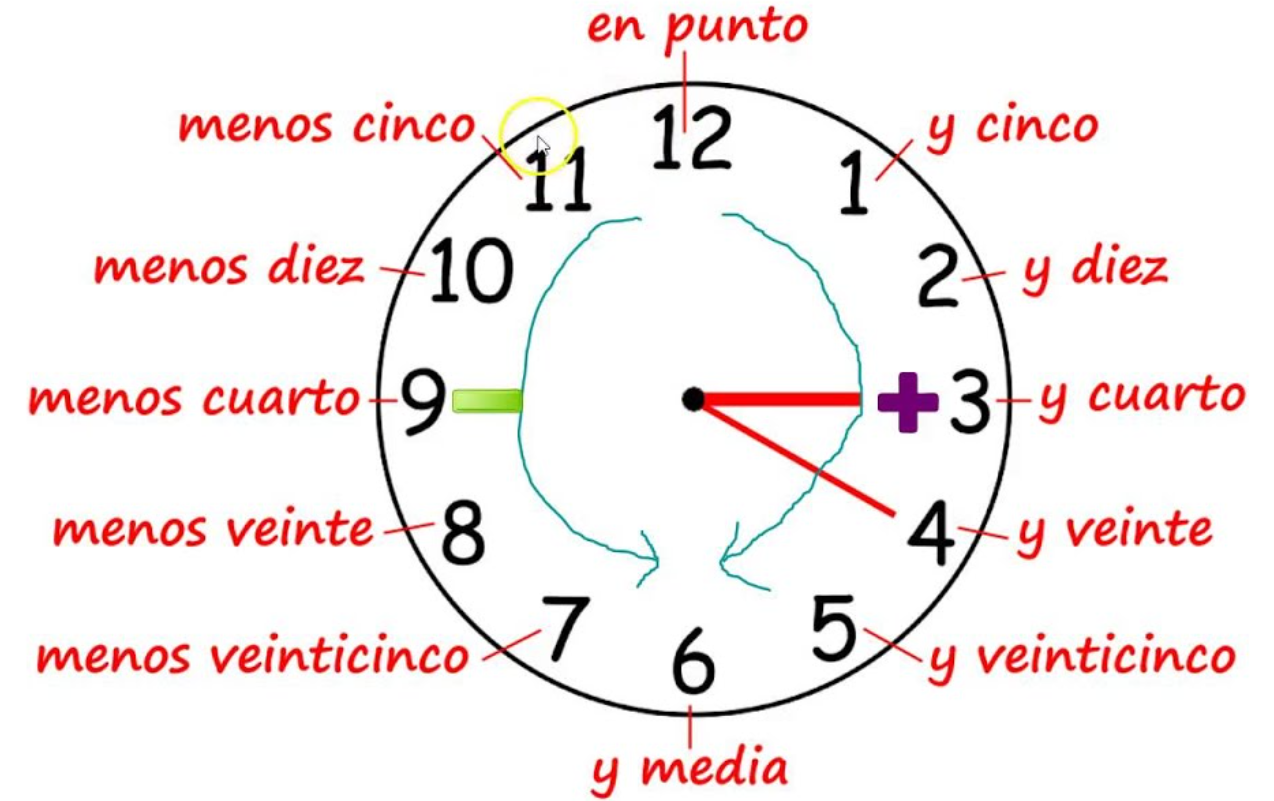Knowing how to tell time in Spanish is key if you plan to spend time in Spanish-speaking places. It makes everyday communication smoother, helping you avoid confusion and delays. It’s crucial for setting up meetings, booking places, or catching a bus. Plus, it lets you join in on local traditions like meal times, siestas, and social events.
In Spanish culture, being on time can be important for some activities but less so for others. Understanding time can help you fit in and interact well.
Basic Rules for Telling Time in Spanish
1. Using “Es la” and “Son las”
- Use “Es la” for 1:00.
- Example: Es la una. (It’s one o’clock.)
- Use “Son las” for all other hours.
- Example: Son las dos. (It’s two o’clock.)
2. Adding Minutes
- To add minutes past the hour, use “y” (and).
- Example: Son las tres y cinco. (It’s 3:05.)
- For quarter past the hour, use “y cuarto.”
- Example: Son las cuatro y cuarto. (It’s 4:15.)
- For half past the hour, use “y media.”
- Example: Son las cinco y media. (It’s 5:30.)
3. Subtracting Minutes
- To indicate minutes until the next hour, use “menos” (minus).
- Example: Son las seis menos veinte. (It’s 5:40.)
- For quarter to the hour, use “menos cuarto.”
- Example: Son las siete menos cuarto. (It’s 6:45.)
4. Special Times: Noon and Midnight
- “Es mediodía” is used for noon.
- Example: Es mediodía. (It’s noon.)
- “Es medianoche” is used for midnight.
- Example: Es medianoche. (It’s midnight.)
5. Asking for the Time
- To ask what time it is, use:
- ¿Qué hora es? (What time is it?)
6. Using the 24-Hour Clock
- Especially common in timetables and formal settings, the 24-hour clock avoids AM and PM.
- Example: Son las 15:00. (It’s 15:00 or 3:00 PM.)
7. Contextual Expressions
- When referring to time-specific parts of the day, you can add phrases like:
- de la mañana (in the morning)
- de la tarde (in the afternoon)
- de la noche (in the evening/night)
- Example: Son las ocho de la mañana. (It’s 8:00 AM.)
How to Tell Time in Spanish with Examples

First, if it’s one o’clock, you say ‘es la una.’ For any other hour, it’s ‘son las’ followed by the number. Just add ‘y’ and the minute number for minutes after the hour.
Now, about specifying the time of day—say ‘de la mañana’ for the morning and ‘de la noche’ for the evening. It’s just like using a.m. and p.m. in English. Easy, right?
Basic Concepts
- Whole Hours:
- To say it’s exactly on the hour, use “Es la una” for 1:00 and “Son las [number]” for all other hours.
- Example:
- Es la una – It’s one o’clock.
- Son las cuatro – It’s four o’clock.
- Minutes Past the Hour:
- Use “y” to add minutes past the hour.
- Example:
- Son las dos y cinco – It’s 2:05.
- Son las once y veinte – It’s 11:20.
- Minutes Until the Next Hour:
- Use “menos” to subtract minutes from the next hour.
- Example:
- Son las diez menos cuarto (9:45) – It’s a quarter to ten.
- Son las cinco menos diez (4:50) – It’s ten to five.
Specific Times
- Quarter Past and Quarter To:
- “Cuarto” means quarter.
- Example:
- Son las tres y cuarto – It’s quarter past three.
- Son las ocho menos cuarto – It’s quarter to eight.
- Half Past:
- “Media” means half.
- Example:
- Son las seis y media – It’s half past six.
- Midnight and Noon:
- Example:
- Es medianoche – It’s midnight.
- Es mediodía – It’s noon.
- Example:
Asking for the Time
- ¿Qué hora es? – What time is it?
Examples in Sentences
- ¿Puedes decirme qué hora es? – Can you tell me what time it is?
- La clase empieza a las nueve en punto. – The class starts at nine o’clock sharp.
- El tren llegará a las cinco y cuarto. – The train will arrive at quarter past five.
- La película termina a las once menos veinte. – The movie ends at twenty to eleven.
Contextual Usage
- A la hora de comer (around lunchtime):
- Vamos a reunirnos a las doce y media para almorzar. – We will meet at twelve-thirty for lunch.
- En la madrugada (in the early morning):
- Tengo que levantarme a las cuatro de la madrugada. – I have to get up at four in the early morning.
- Por la tarde (in the afternoon):
- La conferencia es a las tres de la tarde. – The conference is at three in the afternoon.
Conclusion
To wrap it up, learning to tell time in Spanish is helpful. It helps you in everyday talks and lets you connect better with the culture. Understanding how to use the verb ‘ser’ and correctly say the hours and minutes is essential. This skill is key for clear communication in Spanish-speaking places. Keep practising, and you’ll get better and more confident in these time-related chats.

